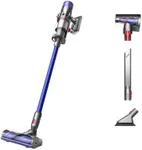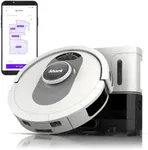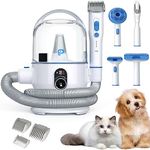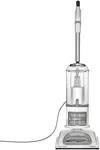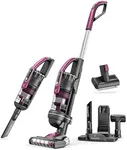Buying Guide for the Best vacuum for dog hair on carpet
Choosing the right vacuum cleaner for dog hair on carpet can make a significant difference in maintaining a clean home. Dog hair can be particularly challenging to remove from carpets, so it's important to consider specific features that will help you tackle this task effectively. Here are some key specifications to look for and how to choose the best fit for your needs.Suction PowerSuction power is the force with which the vacuum cleaner pulls in dirt and debris. This spec is crucial for picking up dog hair embedded in carpet fibers. Higher suction power means better performance in removing stubborn pet hair. Suction power is often measured in watts or air watts. For homes with thick carpets and heavy shedding pets, a vacuum with higher suction power (around 200 air watts or more) is recommended. For lighter shedding or thinner carpets, a moderate suction power (100-200 air watts) may suffice.
Brush RollThe brush roll, or beater bar, is a rotating brush that helps lift hair and dirt from the carpet. This feature is essential for effectively removing dog hair. Look for a vacuum with a motorized brush roll, as it provides more power and efficiency compared to a non-motorized one. Some models offer adjustable brush rolls, which can be beneficial for switching between carpet and hard floors. If you have deep-pile carpets, a vacuum with a strong, motorized brush roll is ideal. For low-pile carpets, a standard brush roll should be sufficient.
Filtration SystemA good filtration system ensures that the vacuum traps dust, dander, and allergens, preventing them from being released back into the air. This is particularly important for pet owners. HEPA (High-Efficiency Particulate Air) filters are the gold standard, capturing 99.97% of particles as small as 0.3 microns. If you or anyone in your household has allergies or asthma, a vacuum with a HEPA filter is highly recommended. For general use, a vacuum with a good multi-stage filtration system can also be effective.
Bagged vs. BaglessVacuum cleaners come in bagged and bagless varieties. Bagged vacuums use disposable bags to collect dirt, which can be more hygienic and easier to dispose of without releasing dust. Bagless vacuums use a dustbin that needs to be emptied regularly. Bagged vacuums are often better for allergy sufferers, as they contain dust and allergens more effectively. Bagless vacuums are more convenient and cost-effective in the long run, as you don't need to buy replacement bags. Choose based on your preference for convenience versus hygiene.
Attachments and AccessoriesAttachments and accessories can enhance the vacuum's ability to clean pet hair from various surfaces. Look for vacuums that come with pet-specific tools, such as a pet hair brush, upholstery tool, and crevice tool. These attachments can help you clean furniture, stairs, and other hard-to-reach areas where pet hair accumulates. If you have multiple pets or a large home, having a variety of attachments can make cleaning more efficient and thorough.
Weight and ManeuverabilityThe weight and maneuverability of a vacuum cleaner affect how easy it is to use, especially if you need to carry it up and down stairs or move it around furniture. Lightweight vacuums are easier to handle and less tiring to use. However, they may have less powerful motors. Upright vacuums are generally heavier but offer strong suction and are good for large carpeted areas. Stick vacuums are lighter and more maneuverable but may have less suction power. Choose based on your physical ability and the layout of your home.
Noise LevelThe noise level of a vacuum cleaner can be an important consideration, especially if you have pets that are sensitive to loud sounds. Noise levels are measured in decibels (dB). Quieter vacuums typically operate at around 60-70 dB, while louder models can exceed 80 dB. If your pets are easily frightened or you prefer a quieter cleaning experience, look for a vacuum with a lower noise level. Keep in mind that quieter vacuums may have less powerful motors, so balance noise level with suction power based on your needs.



